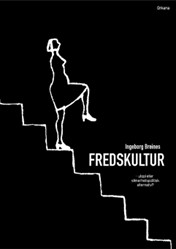Is it possible to see the UNESCO/UN culture of peace program as a blueprint for a feminist, non-violent security policy? Are there alternatives to war and militarisation, or is the culture of peace just utopia? Can a more pacifist view help us out of the increasing horrors of war?
These are questions that I, Ingeborg Breines, a former UNESCO director and president of the International Peace Bureau, raise in my new book The Culture of Peace – Utopia or Alternative Security Policy? published May 2023, by the Orkana Publishing House, Stamsund/Oslo. The publication, which is written in Norwegian, has gotten good reviews. It consists of 416 pages in hard cover and includes rich reference material and some illustrations.
The publication has three parts. The introduction describes my intentions writing the book and the challenges facing the culture of peace vision. (See attached table of contents.) I argue both for peace on earth and peace with the earth. Drawing on my background, I challenge the old thinking that “Si vis pacem, para bellum/If you want peace, prepare for war”. For the survival of humanity I consider it urgent to develop a new paradigm and new structures and practices underlining that “If you want peace, prepare for peace”!
Part I describes the culture of peace program of UNESCO/UN – the origin, the process, the vision, the goals, the partners, the hopes, the enthusiasm, the achievements. I try to bring to the forefront a series of guiding documents, inspiring projects and publications such as the International Year for a Culture of Peace, the International Decade for a Culture of Peace and Non-violence for the Children of the World, the Manifesto 2000 on a Culture of Peace, the Seville Declaration on Violence, the Statement on Women’s Contribution to a Culture of peace, the Declaration on the Right to Peace and not least the Constitution of UNESCO with its emphasis on international intellectual and ethical cooperation and its credo: “Since wars begin in the minds of men, it is in the minds of men that defences for peace must be constructed” .
Part II highlights factors that hinder the culture of peace to take roots, notably the broad and growing militarization, not only of society but also of the human mind. I argue that humanity is facing three alarming existential crises: (i) the climate and environmental catastrophe, (ii) the growing gap between the “haves” and the “have-nots”, and (iii) the nuclear arms threat. I consider that the military-industrial complex seriously – economically, ecologically and ethically – stand in the way of finding innovative and sustainable solutions to the challenges facing humanity.
Part III presents an holistic approach to peace-building based on the eight pillars of the UNESCO/UN culture of peace program: (i) Learn to live together, (ii) Promote sustainable social and economic development, (iii) Promote respect for human rights, (iv) Secure equality between women and men, (v) Foster democratic participation, (vi) Foster understanding, tolerance and solidarity, (vii) Promote free flow of information and knowledge, (viii) Foster international peace and security, with special emphasis on pillar one on education and pillar eight on peace-building. Part III contains descriptions of relevant international structures and institutions, both within the UN system and regional and sub-regional ones, as well as peace building projects and ideas, including from the international peace movement and visionary individuals. Seen together, the publication provides both important knowledge and suggestions for a hoped for and effective transition from a culture of war and violence towards cultures of peace and non-violence.
Blurb
Military expenditure was reduced in the period between the fall of the Berlin Wall in 1989 and the attack on the Twin Towers in New York in 2001 and many people started to hope that finally the world’s military and political resources would be used for welfare instead of warfare. UNESCO developed a global program for a culture of peace that got broad and enthusiastic support. Individuals, organisations, institutions and countries contributed to the development of the vision of a culture of peace and got inspiration, energy and sense of community and meaning. ? The UN, both in a visionary and hopeful way, put the culture of peace as the headline for the new millennium.
But the war against terror changed everything. Also Norway participated in wars in countries where we had no controversies. Fear, enemy images and suspicion were created – again. The climate- and environmental crisis is threatening both humanity and the planet. A worldwide pandemic has further aggravated poverty, violence against women and social unrest.
The war in Ukraine has brought the horrors of war closer to us. Could it lead to disgust for all war, for war as an option? Could the vision and experience of a culture of peace help us stand against a dominating and desperate belief that weapons, ever more numerous, ever more lethal and potentially capable of full extinction of humanity, and that it is necessary in order to build peace and justice? Is the time ripe for acknowledging that it is only through disarmament and détente that we can manage to meet the ecological and social challenges facing us?
This book is a contribution to the strengthening of the world’s fragile peace architecture and gives suggestions as to how a culture of peace may be build through education, diplomacy, dialogue, democracy, justice, gender equality, art, culture and sound common sense.


